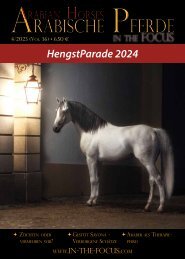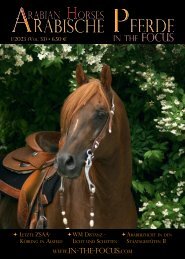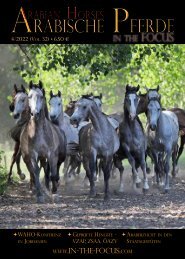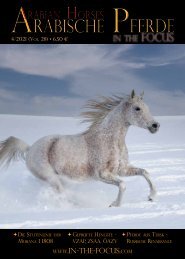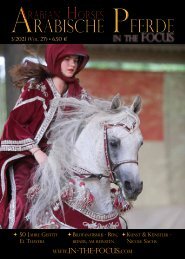Arabische Pferde IN THE FOCUS Nr. 2/2019 - Preview
Zeitschrift für Liebhaber arabischer Pferde
Zeitschrift für Liebhaber arabischer Pferde
Erfolgreiche ePaper selbst erstellen
Machen Sie aus Ihren PDF Publikationen ein blätterbares Flipbook mit unserer einzigartigen Google optimierten e-Paper Software.
vollständigen Stammbaum zusammenzustellen.<br />
Anstatt alle Vorfahren eines <strong>Pferde</strong>s<br />
als "Kuheilan Kharass" zu benennen, reicht<br />
es aus, dass seine Mutter "Kuheila" ist und<br />
vom "Kharass"-Marbat des Al-Qamsa-Clans<br />
des Anazah-Stammes stammt. Jeder Beduine<br />
könnte das sehr gut entziffern!<br />
In ähnlicher Weise bedeutet Obeya Sharrakiya<br />
von Ibn Samdan eine Obeya-Stute, die<br />
aus dem Marbat von Ibn Samdan (einer Person)<br />
stammt und zum Sharrakiya Marbat (benannt<br />
nach einer Person namens Sharrak) des<br />
Sba'a-Clans des Anazah-Stammes zurückreicht.<br />
Ibn Samdan ist in diesem Fall der Besitzer<br />
eines Marbat-Gestüts, das einen berühmten<br />
Zweig des Sharrak-Gestüts erworben hat.<br />
Dieser kurze Ausdruck (Obeya Sharrakiya von<br />
Ibn Samdan) deutet tatsächlich auf einen<br />
Zweig (Unterstamm) und einen Sub-Zweig<br />
(Unter-Unterstamm) des ursprünglichen<br />
Obeya-Stamms hin. Da Sharrak früher ein<br />
sehr berühmter Züchter von Obeya-Qualitätsstuten<br />
war, wurde Ibn Samdan (der jüngere)<br />
auch für Obeya berühmt, da er von den<br />
Wüstenzüchtern (dem Netzwerk!) als besonders<br />
authentischer Zweig anerkannt wurde.<br />
Ein Zweig von Sharraks Linie von Obeya<br />
und sein Name wurde zur weiteren Identifizierung<br />
hinzugefügt. Da Sie immer nur eine<br />
Sorte (Rasan) für ein einzelnes Pferd haben,<br />
können Sie eine oder zwei Marbat-Sorten<br />
hintereinander als Zweig einer anderen Sorte<br />
haben, die beide berühmt dafür waren, diesen<br />
Rasan zu züchten.<br />
Ein vollständiges Beduinenpferdezeugnis<br />
könnte also folgendermaßen aussehen:<br />
"Ein fünfjähriger Brauner, Hengst, Saqlawi<br />
(rasan) Jadraini (marbat) von Ibn Zubaini<br />
(ein weiterer marbat), gezogen von Ujail Ibn<br />
Jadban (Züchter), gezeugt von einem Kuheilan<br />
(rasan) Khadli (marbat) von Meqhem Ibn<br />
Mehid (Züchter)".<br />
Sie haben hier genau zehn Informationen<br />
in diesem vollständig informativen und in<br />
sich geschlossenen Zertifikat! Wenn Sie nicht<br />
wissen, wer Ibn Zubaini ist oder was Khadli<br />
bedeutet, sind Sie kein Beduine oder zumindest<br />
kein Wüstenzüchter. Diese Namen sind<br />
das wesentliche Wissen, das die Beduinen<br />
austauschen, um den Bezugsrahmen für die<br />
Interpretation (oder Entschlüsselung) ihrer<br />
Stammbäume zu bilden. Während moderne<br />
Stammbäume äußerst detailliert sind und keine<br />
speziellen Kenntnisse ihrer Benutzer voraussetzen,<br />
gehen Beduinenstammbäume von<br />
einem Bezugsrahmen aus, der einen früheren<br />
Kontext der Zuchtgesellschaft und Netzwerke<br />
in Arabien darstellt. Jeder Stamm hat seine<br />
eigenen Experten, die dieses Wissen pflegen<br />
und verbreiten, und die Stammes-Scheichs<br />
sind die ultimative Autorität dafür.<br />
Mit solchen Zeugnissen / Stammbäumen<br />
wußte ein Beduine alles, was er wissen musste.<br />
Beduinenstammbäume sind einfach und<br />
präzise und können leicht auswendig gelernt<br />
und ausgetauscht werden, wenn man<br />
bedenkt, dass es keine Aufzeichnungen und<br />
natürlich keine Computerdatenbanken gab!<br />
Yasser Ghanim Al-Tahawi<br />
2/<strong>2019</strong> - www.in-the-focus.com<br />
Kuhailan Tamri, *1916 - sein Pedigree<br />
geht zurück auf die Kuhailan Tamri-Stute,<br />
die 1875 nach Ägypten importiert<br />
wurde durch Saoud Al-Tahawi.<br />
Die Stute stammte von Nasser Al-Ma'jil<br />
vom Beduinenstamme der Anazeh.<br />
Das Foto wurde 1935 aufgenommen<br />
und zeigt Sheikh Abdulla Saoud<br />
Al-Tahawi.<br />
Kuhailan Tamri, *1916, tracing back to<br />
the Kuhailan Tamri mare imported to<br />
Egypt by Saoud Al-Tahawi in 1875 from<br />
Nasser Al-Ma'jil of the Anazah Tribe.<br />
The picture is from 1935, and the rider is<br />
Sheikh Abdullah Saoud Al-Tahawi.<br />
all photos: Tahawi Archive, managed by<br />
Mohammed Saoud Al-Tahawi<br />
53<br />
dam line (strain) of this mare. When a new<br />
filly comes to existence the sire is very well<br />
known. When this filly becomes a mare and<br />
produces we know the new sire. These sires<br />
information are kept for one or two generations<br />
only and becomes irrelevant afterward.<br />
This accumulative process is maintained by<br />
a big network of Bedouin Sheikhs who witness<br />
and verify the breeding process and<br />
won’t assign a strain to a suspicious individual<br />
(male or female). Refer again to the<br />
study about the history of strains and how<br />
they developed.<br />
The result of the above analysis is that we<br />
have two basic rules for generating Bedouin<br />
pedigrees. First: strain is the most important<br />
identifier of an Asil Arabian. Second: sire<br />
information are temporal, while dam line<br />
information are persistent and gradually<br />
subsumes sires information.<br />
Based on these two rules, and adding a couple<br />
of pieces of other details like color and age,<br />
Bedouin pedigrees can be as simple as follows:<br />
Horse, color, age, Dam, Sire, Dam's Sire, direct<br />
breeder.<br />
Note that Bedouins always start with the<br />
dam in contrary to modern pedigrees.<br />
Each horse here is expressed in a Rasan-Marbat<br />
pair of names. This gives as low as ten<br />
pieces of information to assemble a complete<br />
pedigree. So instead of giving all the ancestors<br />
of a horse, saying that he is "Kuehilan<br />
Kharass" means his dam is "Kuheila" coming<br />
from the "Kharass" Marbat of Al-Qamsa clan<br />
of the Anazah tribe. Any Bedouin could very<br />
well decipher this!<br />
Similarly when you say: Obeya Sharrakiya of<br />
Ibn Samdan it means an Obeya mare coming<br />
from the Marbat of Ibn Samdan (a person)<br />
tracing to the Sharrakiya Marbat (named after<br />
a person called Sharrak) of the Sba'a clan<br />
of the Anazah tribe. Ibn Samdan in this case is<br />
the owner of a Marbat (stud) that acquired a<br />
famous branch of the Sharrak stud. This short<br />
expression (Obeya Sharrakiya of Ibn Samdan)<br />
actually suggests a branch (sub-strain)<br />
and sub-branch (sub- sub-strain) of the<br />
Obeya original strain. As Sharrak used to be a<br />
very famous breeder of quality Obeya mares<br />
to the extent that he is then acknowledged by<br />
the desert breeders (the network!) as a special<br />
authentic branch of Obeya, Ibn Samdan<br />
(who is more recent) became also famous for<br />
a branch of Sharrak's line of Obyea and his<br />
name was added for further identification. So<br />
as you always have one and only one Strain<br />
(Rasan) for a single horse, you can have a succession<br />
of one or two Marbats one as branch<br />
of another who were both famed for breeding<br />
this Rasan.<br />
So, a complete Bedouin horse certificate can be:<br />
"A five year, bay, stallion, Saqlawi (rasan)<br />
Jadraini (marbat) of Ibn Zubaini (another<br />
marbat), bred by Ujail Ibn Jadban (breeder),<br />
sired by A Kuheilan (rasan) Khadli (marbat)<br />
of Meqhem Ibn Mehid (breeder)".<br />
You have here exactly ten pieces of information<br />
in this fully informative and self contained<br />
certificate! Now if you don't know who<br />
Ibn Zubaini is, or what does Khadli mean you<br />
are not a Bedouin or at least you are not a<br />
desert breeder. These names are the essential<br />
knowledge that the Bedouins exchange to<br />
form the frame of reference for interpreting<br />
(or deciphering) their pedigrees. While modern<br />
pedigrees are extremely detailed and<br />
assume no specialized knowledge of their<br />
users, Bedouin pedigrees assume a frame<br />
of reference, a prior context of the breeding<br />
society and networks within Arabia. Every<br />
tribe has its own experts who maintain<br />
and spread this knowledge, and the tribal<br />
Sheikhs are the ultimate authority for this.<br />
Using such certificates/pedigrees, a Bedouin<br />
could know everything he needed to know.<br />
Bedouin Pedigrees are simple and precise<br />
and can easily get memorized and exchanged<br />
considering a time there was no records<br />
and of course no computer databases!<br />
Yasser Ghanim Al-Tahawi<br />
History and Tradition



